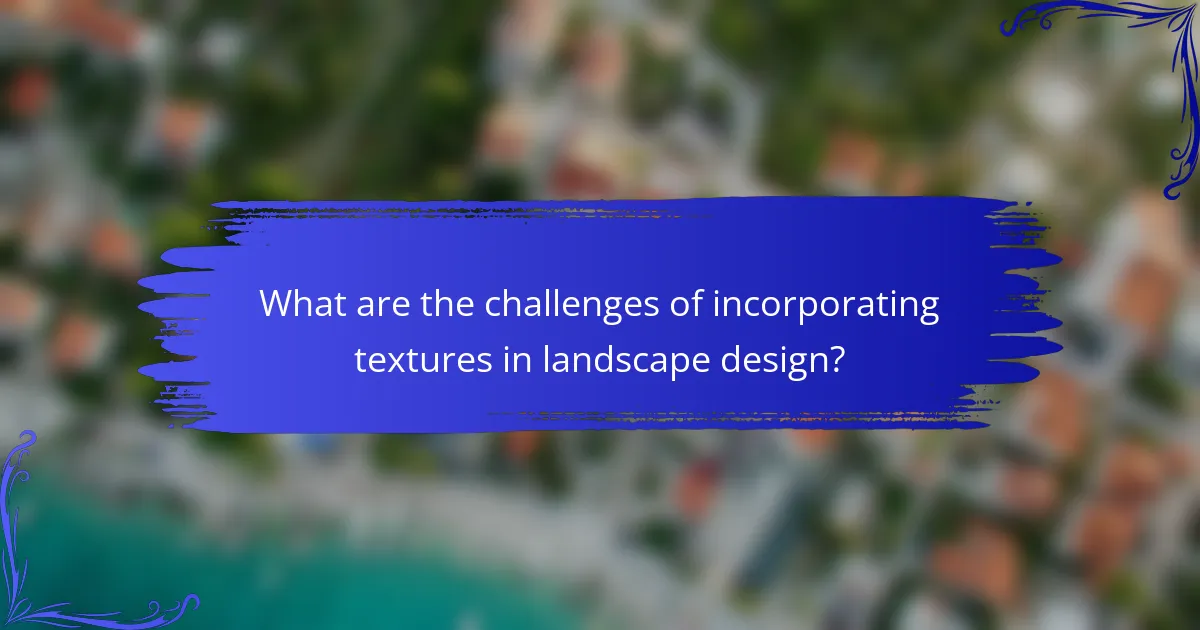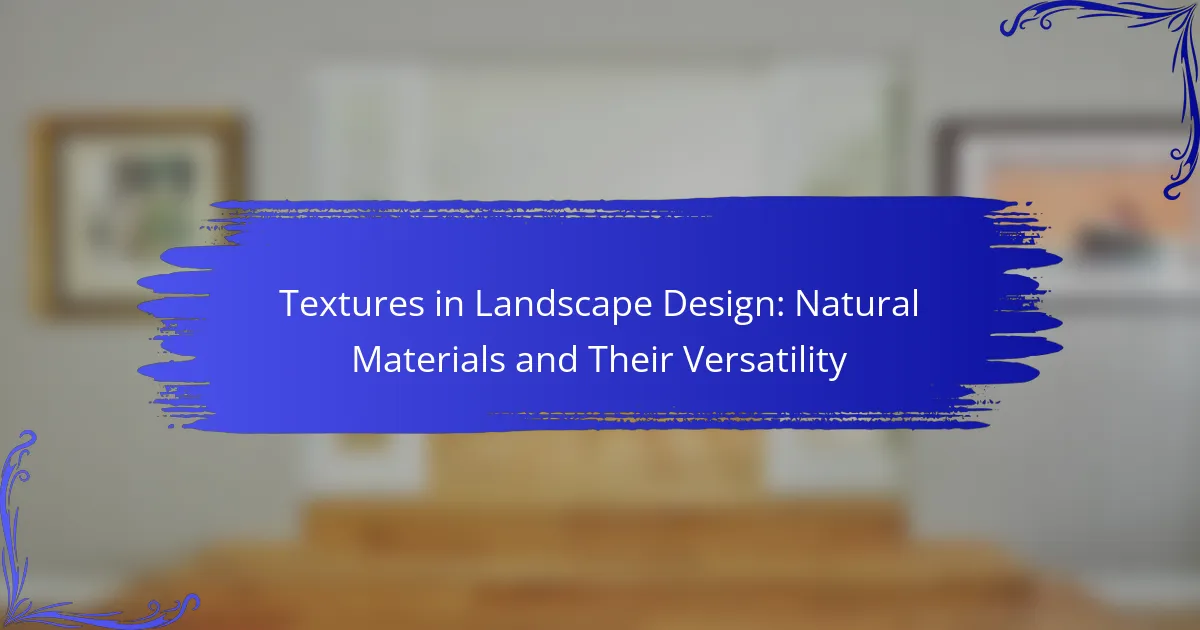Textures in landscape design refer to the surface quality and visual appearance of materials used in outdoor spaces, influencing both aesthetics and functionality. This article explores the various textures created by natural materials such as stone, wood, and plants, highlighting their benefits, including aesthetic appeal, sustainability, and support for local biodiversity. It also addresses challenges in incorporating textures, such as achieving visual balance, ensuring compatibility with the environment, and managing maintenance and budget constraints. The thoughtful application of textures is essential for creating harmonious and engaging landscapes that enhance the overall experience of outdoor spaces.

What are Textures in Landscape Design?
Textures in landscape design refer to the surface quality and visual appearance of materials used in outdoor spaces. These textures can be rough, smooth, glossy, or matte and contribute to the overall aesthetic of a landscape. Different materials, such as stone, wood, and plants, offer unique textures that enhance visual interest. For instance, rough stone pathways provide a natural feel, while smooth wooden decks create warmth. The interplay of various textures can evoke emotions and influence the perception of space. Textures also play a role in functional aspects, such as safety and accessibility, by providing grip or contrast. Overall, the thoughtful use of textures is essential in creating harmonious and engaging landscapes.
How do natural materials contribute to landscape textures?
Natural materials significantly contribute to landscape textures by providing varied tactile and visual experiences. These materials include stone, wood, soil, and plant life. Each type of natural material has unique characteristics that affect texture. For example, rough stones create a rugged texture, while smooth pebbles offer a softer feel. Wood can be textured through bark or grain patterns, adding warmth to landscapes. Soil types, such as clay or sand, also influence texture through their composition and drainage properties. Plant life introduces dynamic textures that change with seasons, such as the softness of grasses or the roughness of tree bark. The combination of these materials enhances the overall aesthetic and sensory experience of a landscape.
What types of natural materials are commonly used?
Commonly used natural materials in landscape design include stone, wood, and soil. Stone is often utilized for pathways, walls, and decorative features. Wood serves as a versatile material for decking, fencing, and furniture. Soil is essential for planting and creating garden beds. Additionally, gravel is frequently used for drainage and ground cover. These materials are favored for their aesthetic appeal and durability. Their use is supported by historical practices in landscape architecture, emphasizing a connection to nature.
How do these materials affect the overall aesthetic?
Natural materials significantly enhance the overall aesthetic of landscape design. They provide a sense of authenticity and connection to nature. For instance, wood brings warmth and organic texture, while stone adds permanence and rugged beauty. The color palette of natural materials often harmonizes with the surrounding environment. This creates a cohesive visual experience. Additionally, the variation in textures can evoke different moods. Smooth surfaces may impart calmness, while rough textures can add interest and dynamism. Studies show that landscapes using natural materials are perceived as more inviting and pleasant. These materials not only serve functional purposes but also elevate the visual appeal of outdoor spaces.
Why is versatility important in landscape design?
Versatility is important in landscape design because it allows for adaptability to various environmental conditions and aesthetic preferences. A versatile landscape can accommodate changes in weather, season, and user needs. This adaptability enhances functionality and ensures that the space remains appealing over time. For example, using a mix of native plants can create a resilient garden that thrives in local conditions. Additionally, versatile materials such as stone, wood, and metal can be used in multiple ways to create diverse textures and forms. This diversity in design elements contributes to visual interest and harmony within the landscape. Ultimately, versatility enriches the landscape experience and increases its longevity.
How can different textures enhance functionality?
Different textures enhance functionality by providing distinct visual and tactile experiences. Textures can influence the perception of space and depth in landscape design. For example, rough textures can create a sense of ruggedness, while smooth textures offer a more refined appearance. Additionally, varying textures can improve safety by offering grip on surfaces like pathways. Textures also affect water retention and drainage in soil, influencing plant health. According to a study by the University of Massachusetts, diverse textures in landscapes can enhance biodiversity and ecosystem resilience. This demonstrates that texture choices are integral to both aesthetics and practical landscape performance.
What role do textures play in seasonal changes?
Textures influence the perception of seasonal changes in landscapes. They contribute to visual interest and evoke emotional responses. For instance, rough textures like tree bark become more prominent in fall as leaves change color. Smooth textures, such as water surfaces, reflect seasonal light differently throughout the year. The contrast between soft and hard surfaces enhances the seasonal experience. Textures also affect plant selection, influencing biodiversity in different seasons. Seasonal textures can signal changes in climate, such as frost on grass or blooming flowers in spring. Overall, textures are essential in shaping the seasonal character of a landscape.

What are the benefits of using natural materials in landscape design?
Using natural materials in landscape design offers multiple benefits. They enhance aesthetic appeal by blending seamlessly with the environment. Natural materials, such as stone, wood, and plants, create organic textures that evoke a sense of harmony. They are often more sustainable compared to synthetic alternatives. Natural materials typically have a lower carbon footprint, as they require less energy to produce. Additionally, they promote biodiversity by supporting local ecosystems. For instance, native plants used in landscaping can attract local wildlife. Their durability ensures that they withstand various weather conditions, reducing maintenance costs over time. Overall, natural materials contribute to a healthier environment and a more visually pleasing landscape.
How do natural materials promote sustainability?
Natural materials promote sustainability by reducing environmental impact and enhancing ecosystem health. They are often biodegradable and have lower carbon footprints compared to synthetic alternatives. For example, wood is a renewable resource when sourced sustainably. Natural materials like stone and clay require less energy to process. They also support local economies by utilizing regional resources. Additionally, these materials can improve soil health and biodiversity when used in landscaping. Studies show that landscapes designed with natural materials can better manage water runoff and reduce erosion. This leads to healthier ecosystems and more resilient landscapes.
What are the environmental benefits of using local materials?
Using local materials reduces transportation emissions and supports sustainability. This practice minimizes the carbon footprint associated with long-distance shipping. Local materials often require less energy for processing, contributing to lower overall environmental impact. They also encourage the preservation of local ecosystems by promoting the use of native resources. Utilizing local resources can enhance biodiversity by maintaining regional characteristics. Studies show that sourcing materials locally can lead to more sustainable construction practices. For example, a report by the U.S. Green Building Council indicates that local sourcing can cut transportation-related emissions by up to 80%.
How do natural materials reduce maintenance needs?
Natural materials reduce maintenance needs by offering durability and resilience. These materials, such as stone, wood, and clay, typically withstand environmental stressors better than synthetic alternatives. For instance, stone surfaces resist weathering and do not require frequent replacement. Wood, when treated properly, can last for years with minimal upkeep. Natural materials also promote better drainage and soil health, reducing the need for irrigation and chemical treatments. According to a study by the University of California, landscaping with native plants, which are often natural materials, can cut water usage by up to 50%. This efficiency translates to lower maintenance costs and less labor over time.
How do textures influence the sensory experience in landscapes?
Textures significantly influence the sensory experience in landscapes by affecting how individuals perceive and interact with their environment. Different textures, such as rough, smooth, soft, or hard, evoke varied tactile sensations. These sensations can enhance emotional responses, creating feelings of comfort or stimulation. For example, a soft grass surface invites relaxation, while a rough stone path may encourage exploration. Textures also impact visual aesthetics, contributing to the overall beauty and complexity of a landscape. Research indicates that diverse textures can improve spatial perception and depth, making landscapes feel more dynamic. In essence, textures play a crucial role in shaping the sensory experience, influencing both emotional and cognitive responses to landscapes.
What textures engage touch and feel in landscape design?
Textures that engage touch and feel in landscape design include rough, smooth, soft, and hard surfaces. Rough textures, such as bark or stone, provide tactile contrast and interest. Smooth surfaces, like polished stone or glass, offer a sleek feel. Soft textures, such as moss or certain grasses, invite interaction and comfort. Hard textures, including concrete or metal, create a sense of structure and durability. The combination of these textures enhances sensory experiences in outdoor spaces. Research shows that varied textures can influence user engagement and emotional responses in landscapes.
How do visual textures impact perception and mood?
Visual textures significantly influence perception and mood. Different textures evoke various emotional responses. For instance, smooth textures often create feelings of calmness and serenity. In contrast, rough textures can induce a sense of energy or dynamism. Research indicates that people associate soft textures with comfort and safety. A study published in the Journal of Environmental Psychology shows that natural textures enhance feelings of well-being. Textures can also affect spatial perception, making spaces feel larger or cozier. This impact on mood and perception is crucial in landscape design. Using diverse textures can create a balanced and inviting environment.

What are the challenges of incorporating textures in landscape design?
Incorporating textures in landscape design presents various challenges. One challenge is achieving visual balance among different textures. Too many contrasting textures can create visual chaos. Another challenge is ensuring compatibility with the surrounding environment. Textures must harmonize with existing features and plants. Additionally, maintenance can be difficult with certain textured materials. Some textures may require more upkeep than others. Weather resistance is also a concern. Textures must withstand local climate conditions without degrading. Lastly, budget constraints can limit texture options. High-quality textured materials often come at a premium price. These challenges require careful planning and consideration in landscape design.
How can designers effectively combine different textures?
Designers can effectively combine different textures by considering contrast and harmony. They should select textures that complement each other while creating visual interest. For example, pairing rough stone with smooth wood can create a balanced aesthetic. Additionally, using a variety of scales in textures enhances depth. Designers should also consider the context of the space. Natural materials often work well together due to their organic qualities. Experimentation with layering textures can yield unique results. Testing combinations in small areas before full implementation is advisable. This approach is supported by principles of design that emphasize balance and variety.
What are common pitfalls to avoid when mixing textures?
Common pitfalls to avoid when mixing textures include lack of cohesion and overwhelming variety. Cohesion is essential for creating a harmonious design. Mixing too many different textures can lead to visual chaos. It is important to choose textures that complement each other. Overusing similar textures can also create monotony. Balance is key; aim for a mix of rough and smooth textures. Scale matters; ensure that the size of the textures is proportionate. Lastly, consider the context of the landscape. Each texture should enhance the overall aesthetic of the space.
How can climate affect the choice of textures?
Climate significantly influences the choice of textures in landscape design. Different climates dictate the durability and suitability of materials used in outdoor spaces. For instance, arid climates favor textures that retain moisture, like rough stone or gravel. In contrast, humid climates benefit from smoother surfaces that prevent mold growth, such as polished stone or treated wood. Cold climates often require materials that can withstand freezing temperatures, leading to the use of resilient textures like brick or concrete. Additionally, the aesthetic appeal of textures can vary with climate; warmer regions may prefer earthy, natural textures, while cooler areas might lean towards sleek, modern finishes. This relationship between climate and texture choice is crucial for ensuring both functionality and visual harmony in landscape design.
What are best practices for selecting natural materials?
Best practices for selecting natural materials include assessing sustainability, durability, and aesthetic compatibility. Sustainability ensures that materials are sourced responsibly, minimizing environmental impact. Durability is crucial for longevity in various weather conditions. Aesthetic compatibility involves matching materials with the overall design theme. Additionally, consider local availability to reduce transportation emissions and costs. Research shows that using locally sourced materials can lower carbon footprints significantly. Choosing materials that require minimal maintenance can also enhance the longevity of landscape designs.
How can one assess the suitability of materials for specific projects?
To assess the suitability of materials for specific projects, one must evaluate several key factors. These factors include durability, weather resistance, and aesthetic appeal. Durability ensures the material can withstand environmental conditions over time. Weather resistance protects against elements like moisture and UV exposure. Aesthetic appeal relates to how well the material complements the overall design vision.
Additionally, one should consider the material’s maintenance requirements and cost-effectiveness. Low maintenance materials reduce long-term upkeep efforts. Cost-effectiveness ensures the project stays within budget while achieving desired outcomes.
Conducting tests or seeking expert opinions can further validate material choices. For example, laboratory tests can simulate weather conditions to assess performance. Expert consultations provide insights based on experience and industry standards.
What tips can enhance the versatility of textures in designs?
To enhance the versatility of textures in designs, incorporate a variety of materials. Mixing natural elements like stone, wood, and plants creates dynamic contrasts. Utilize different finishes on surfaces, such as matte and glossy, to add depth. Layering textures can create visual interest and complexity. Use color contrasts to highlight various textures effectively. Scale is important; combining large and small elements can enhance the overall design. Consider the context of the environment to ensure textures complement the landscape. Finally, regularly evaluate and adapt textures to maintain freshness and relevance in designs.
Textures in landscape design refer to the surface quality and visual appearance of materials used in outdoor spaces, significantly impacting aesthetics and functionality. This article explores the role of natural materials, such as stone, wood, and soil, in creating varied textures that enhance visual interest and sensory experiences. It discusses the benefits of using these materials, including sustainability, durability, and their influence on seasonal changes and user engagement. Additionally, the article addresses best practices for selecting and combining textures, as well as the challenges designers may face in achieving balance and harmony within landscape designs.
